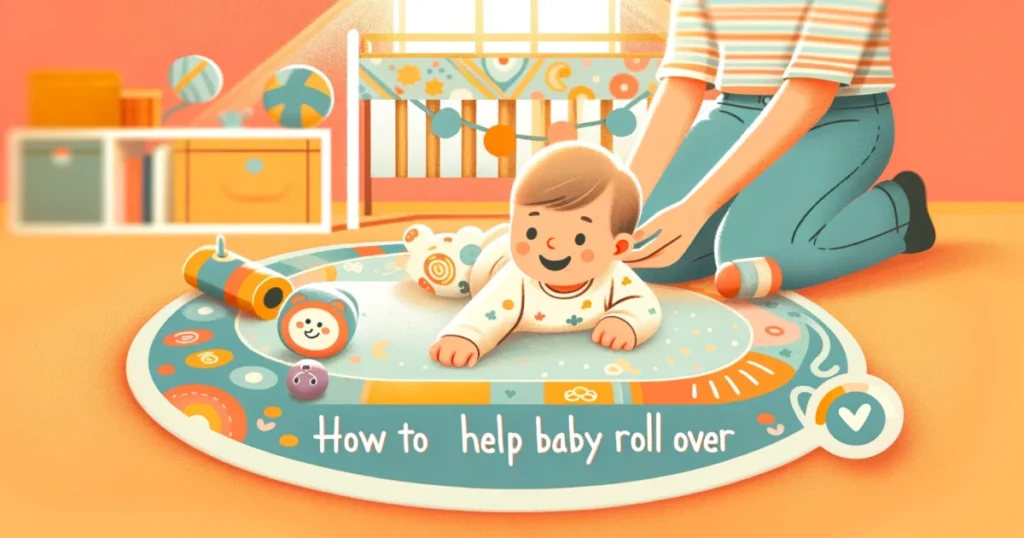Introduction of How to Help Baby Roll Over:
Watching your baby learn to roll over is one of the most exciting milestones in their early development. In this guide, we’ll share some simple yet effective tips on how to help your baby roll over. Rolling over is not just an adorable achievement; it’s a crucial step in your baby’s physical development, paving the way for future movements like crawling and sitting.

Our easy-to-follow strategies are backed by expert advice, ensuring you have all the support you need to assist your little one in mastering this essential skill. Whether you’re a first-time parent or looking for new techniques, this article will help you on how to help baby roll over with the guidance to confidently help your baby reach this important milestone.
Understanding the Importance of Rolling Over:
Rolling over is not just a physical milestone; it’s a significant step in your baby’s developmental journey. This movement marks the beginning of exploring their physical abilities, laying the foundation for more complex activities like crawling. When you help your baby roll over, you’re essentially boosting their muscle development, coordination, and body awareness.
Tip: Encourage your baby’s efforts in rolling over with gentle tummy time exercises, gradually increasing the duration as they grow stronger.
Creating a Safe and Encouraging Space for Rolling Over:
A crucial part of helping your baby roll over is ensuring they have a safe space to practice. This means a clutter-free area with a soft surface where they can move without any hazards. A comfortable environment encourages your baby to try rolling over without any distractions or risks.
Tip: Lay out a soft blanket or a play mat on the floor for your baby’s rolling over sessions, making sure it’s a secure and inviting space for them to move around.
Utilizing Tummy Time to Build Strength:
Tummy time is essential in helping your baby develop the strength they need to roll over. It strengthens their neck, back, and shoulder muscles, all of which are vital for rolling over. Making tummy time a regular part of your baby’s day sets them up for success in learning to roll over.
Tip: Start with short sessions of tummy time and increase the length as your baby becomes more comfortable and stronger.
Encouraging Movement Through Playful Interaction:
Using play to motivate your baby to roll over can make the learning process more enjoyable. Engaging them with colorful toys or playing interactive games can inspire them to reach out, stretch, and eventually roll over. This method turns a developmental exercise into a fun and stimulating activity.
Tip: Place toys just within your baby’s reach during tummy time, encouraging them to stretch and move towards the toys.
Respecting Your Baby’s Unique Development Pace:
Every baby develops at their own pace, and it’s important to respect their individual timeline for rolling over. While some babies might roll over as early as 3 months, others might take a bit longer. Keeping this in mind helps maintain realistic expectations and a patient attitude as you help your baby roll over.
Tip: Celebrate every small sign of progress and avoid comparing your baby’s milestones with others.
Support and Encouragement: Key in How to Help Baby Roll Over:
Your encouragement plays a vital role in your baby’s journey to roll over. Cheering them on, providing gentle guidance, and celebrating their attempts helps build their confidence and eagerness to try.
Tip: Show excitement and give lots of praise when your baby shows efforts to roll over, reinforcing their positive attempts.
Monitoring and Celebrating Each Rolling Milestone:
Keeping track of your baby’s rolling milestones is a great way to monitor their physical development. Noting when they first roll from back to tummy or tummy to back gives you valuable insights into their growth.
Tip: Keep a milestone chart or journal to track and celebrate each new movement your baby achieves.
Incorporating Massage and Sensory Stimulation:
Massage and gentle physical interaction can stimulate your baby’s muscles and sensory development. This not only aids in their physical growth but also provides a calming and bonding experience for both of you.
Tip: Regularly massage your baby’s limbs to encourage movement and help them become more aware of their body.
Seeking Guidance for Rolling Over Milestones:
If you’re concerned about your baby’s progress with rolling over, don’t hesitate to consult a pediatrician. They can provide guidance and reassurance about your baby’s development.
Tip: Bring up any concerns about rolling over during pediatric check-ups to get professional advice and peace of mind.
Celebrating Each Effort Towards How to Help Baby Roll Over:
Every attempt your baby makes to roll over is an achievement worth celebrating. These moments are not only crucial for their physical development but also for building a joyful and encouraging environment.
Tip: Capture these milestones in photos or videos to look back on these special moments and share the joy of their achievements.




